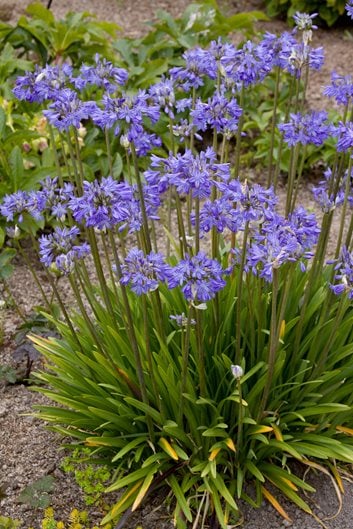Just how to Plant and Maintain Agapanthus in Your Yard
Wiki Article
Understanding the Art of Agapanthus Treatment: Necessary Steps for Healthy And Balanced Development and Dynamic Blossoms
In the world of horticulture, the farming of agapanthus stands as a rewarding undertaking for those who seek to support these stylish blooming plants. From choosing the best range to grasping trimming techniques, the journey in the direction of cultivating prospering agapanthus plants is multifaceted and holds the vital to opening the complete potential of these agricultural gems.
Picking the Right Agapanthus Selection

When picking the appropriate Agapanthus selection for your yard, take into consideration variables such as climate viability, bloom color, and development habit. Agapanthus, commonly understood as Lily of the Nile or African lily, comes in a variety of shades ranging from tones of purple and blue to white. Pick a blossom shade that enhances your existing garden palette to develop an unified landscape. In addition, think about the climate in your region to guarantee the Agapanthus variety you pick can grow in your certain conditions. Some ranges are a lot more forgiving of chilly temperature levels, while others like warmer climates. Recognizing the growth practice of different Agapanthus selections is critical for correct positioning within your yard. Some selections have a clumping development practice, ideal for boundaries or containers, while others have a more dispersing nature, appropriate for ground cover or mass plantings. By carefully reviewing these variables, you can pick the ideal Agapanthus variety to boost the appeal of your yard.
Suitable Growing Conditions
Considering the ideal ecological needs is vital for effective Agapanthus cultivation. Agapanthus plants are sensitive to chilly temperature levels and should be safeguarded from frost throughout wintertime months.To ensure healthy development and vivid blooms, plant Agapanthus bulbs at a depth of regarding 2-4 inches and room them 8-12 inches apart. Including raw material, such as compost, to the soil can enhance drainage and fertility, promoting durable origin advancement. Mulching around the base of the plants helps retain moisture and reduces weed development. Routine watering is critical, specifically during the growing period, to maintain the dirt regularly damp however not waterlogged.
Watering and Fertilizing Tips
Maintaining proper dampness degrees and offering essential nutrients are crucial components in the treatment regimen for Agapanthus plants. When it comes to watering Agapanthus, it is critical to strike an equilibrium. These plants prefer continually damp dirt however are at risk to root rot if overwatered.Feeding Agapanthus is important for advertising healthy growth and respected blooms. Apply a well balanced plant food, such as a 10-10-10 formula, in the early spring as brand-new development emerges. By following these watering and fertilizing suggestions, you can guarantee your Agapanthus plants thrive and generate vibrant, lasting blossoms.
Trimming Strategies for Agapanthus
Pruning Agapanthus plants at the proper times and with correct strategies is essential for preserving their wellness and advertising optimal growth and flowering. The optimal time to trim Agapanthus is in late wintertime or very early spring prior to new growth arises. Begin by eliminating any yellowing or dead fallen leaves near the base of the plant. Cut them as short as possible without harming the arising shoots.Deadheading invested blossoms can likewise redirect the plant's power right into creating more blossoms instead than setting seeds. If you want to accumulate seeds for breeding, leave some flowers to dry and fully grown on the plant.
Keep in mind to Learn More utilize clean, sharp devices to make accurate cuts and decrease the risk of presenting illness. Agapanthus. Routine pruning will certainly assist keep your Agapanthus looking cool and healthy and balanced while making certain an abundant display of beautiful blossoms
Taking Care Of Common Pests and Conditions
After making certain proper trimming techniques for Agapanthus, it is necessary to address typical pests and illness that can influence the health and vitality of these plants. One usual pest that impacts Agapanthus is the Agapanthus gall midget.In addition, Agapanthus plants can endure from origin rot if they are grown in poorly draining soil. By being watchful and taking prompt action against illness and insects, you can assist your Agapanthus plants prosper and create lively flowers. Agapanthus.

Conclusion
Finally, mastering the art of agapanthus care entails choosing the best range, giving excellent growing problems, appropriate watering and fertilizing, suitable pruning strategies, and resolving typical insects and diseases. By adhering to these crucial actions, you can guarantee healthy development and lively blooms for your agapanthus plants. right here Bear in mind to consistently keep an eye on and preserve your plants to advertise their general well-being and long life.To make sure healthy development and dynamic blooms, plant Agapanthus light bulbs try here at a depth of concerning 2-4 inches and area them 8-12 inches apart. By adhering to these watering and fertilizing tips, you can guarantee your Agapanthus plants flourish and generate dynamic, lasting blossoms.
One common parasite that affects Agapanthus is the Agapanthus gall midget. Furthermore, Agapanthus plants can endure from root rot if they are grown in badly draining pipes soil. By adhering to these important actions, you can ensure healthy and balanced growth and vivid flowers for your agapanthus plants.
Report this wiki page